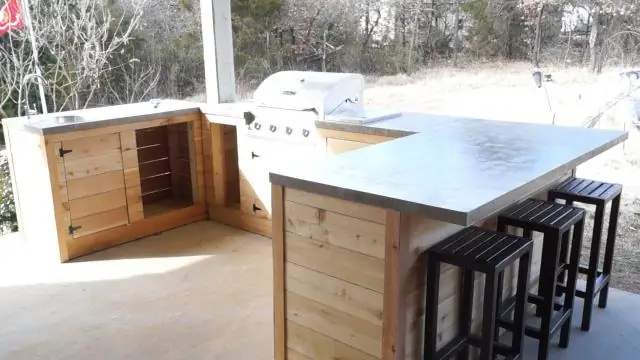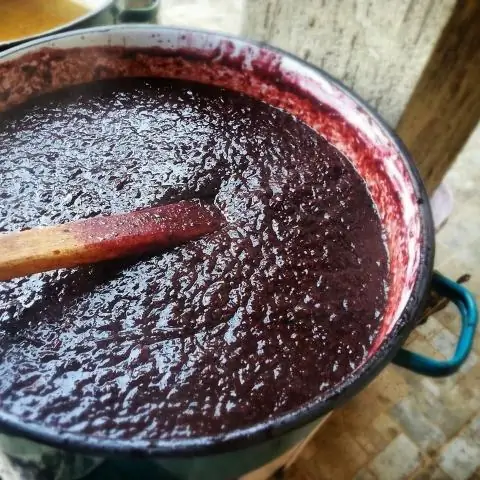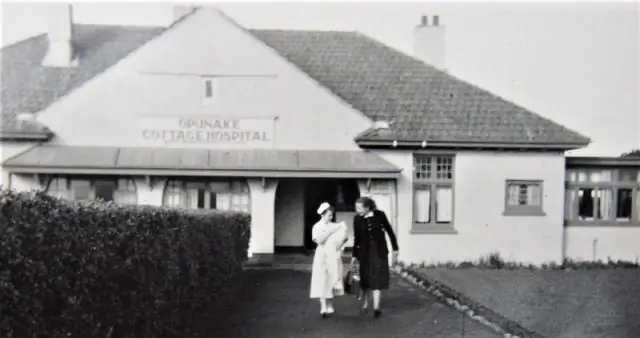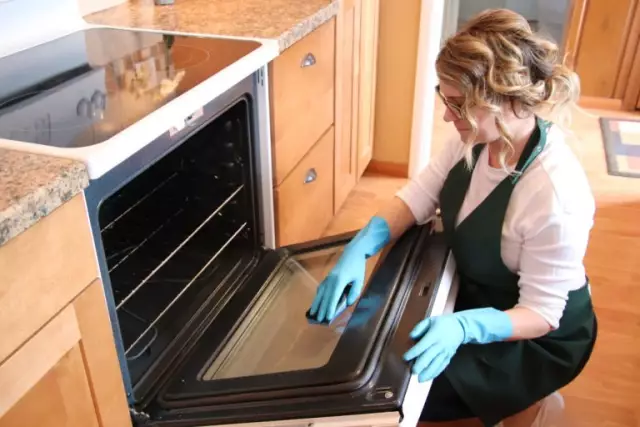
Table of contents:
- How to build a fireplace stove with your own hands
- What is a fireplace stove, its advantages and disadvantages
- Design features and principle of operation
- Calculation of basic parameters
- Required materials and tools
- Preparatory work, choice of location
- Do-it-yourself fireplace stove: step by step instructions
- Chimney installation features
- Features of operation
- Author Bailey Albertson [email protected].
- Public 2023-12-17 12:53.
- Last modified 2025-01-23 12:41.
How to build a fireplace stove with your own hands

Each owner of a country house seeks to organize comfort in his home. An open or closed hearth of flame creates a special atmosphere, which will have a calming effect and warm in the colder months. In order to make the heat source safe and efficient, you can build a corner fireplace with your own hands. This will require drawings of such a structure and masonry skills.
Content
-
1 What is a fireplace stove, its advantages and disadvantages
1.1 Table: advantages and disadvantages of fireplace stoves
- 2 Design features and principle of operation
-
3 Calculation of basic parameters
- 3.1 Calculation of bricks
- 3.2 Calculation of the foundation and mortar for masonry
- 3.3 Video: brick corner fireplace
- 4 Required materials and tools
- 5 Preparatory work, site selection
-
6 Do-it-yourself fireplace stove: step by step instructions
- 6.1 Preparing the masonry mixture
- 6.2 Step by step instructions: features of brickwork
- 7 Features of chimney installation
- 8 Features of operation
What is a fireplace stove, its advantages and disadvantages
A fireplace stove is an aggregate or capital structure made of fire-resistant materials that accumulates heat from the hearth of the flame in the combustion chamber.
These structures are most often used as sources of heat and comfortable interior elements in summer cottages, country houses and private households.

Red refractory brick construction
Fireplace stoves have a number of advantages and disadvantages, which are expressed in the following criteria:
Table: advantages and disadvantages of fireplace stoves
| Advantages | disadvantages |
|
|
Design features and principle of operation
The design of the fireplace stove consists of two main elements - a combustion chamber and a chimney system. The degree of efficiency and productivity of the heating structure depends on how accurately the ratios of their parameters are calculated.
The principle of operation of the fireplace stove is that the flame in the combustion chamber burns when the chimney is open (at the upper end). The smoke is removed by means of a draft, the power of which depends on the length of the pipe. Effective heat radiation occurs during the combustion of the fuel material, but when it burns, the heating is significantly reduced. To increase heat transfer, the fireplace stove is equipped with a convection chamber. This upgrade allows air to circulate from the room to the inside, and the heated air back.
Like any capital structure, the fireplace stove has a solid base.

Corner construction
For fire safety purposes, the structure is equipped with a flood platform. It is placed on the floor in front of the fireplace. For this, non-combustible materials are used - metal, stone, refractory bricks or tiles.
Above the platform is the ash pan cavity and the fuel chamber. The space between these compartments is equipped with a grate. This increases the efficiency of the heating structure, since a place is formed under the burning fuel material for the discharge of the burnt material.
Designs with a closed combustion chamber are equipped with a special blower, thanks to which you can change the heat power inside the fireplace-stove. This makes it possible to extend the burning time, thereby saving fuel material.
All surfaces of the fireplace stove that are in contact with an open flame are laid out with fire-resistant materials. This is necessary, since the temperature in these areas of the fireplace reaches, and sometimes exceeds + 1000 ° C.
To enhance the heat radiation, the back wall of the fireplace stove is equipped with sheets of stainless steel or cast iron. For greater heat transfer, the rear wall of the combustion chamber is built obliquely forward. As a result, heat flows are directed towards the platform, additionally heating the floors.
A smoke collection chamber (hailo) is installed above the combustion chamber. It has an irregular shape, resembling a truncated pyramid, in front of which there is a special barrier. This barrier prevents cold air currents from mixing with the combustion products and also prevents smoke from entering the room.
The chimney tooth prevents soot from falling out into the combustion chamber. To clean this area of the fireplace stove, a door is installed near it.
The smoke collection compartment (hailo) and the chimney system are separated by a metal valve. This element serves to block the path of warm flows from the room to the outside, after the firewood has burned out. The valve is also used to adjust the draft.
The chimney pipe is erected according to the same principle as in other heating structures. To ensure good draft, its height should be at least 500 cm from the base of the combustion chamber.
Calculation of basic parameters
The efficiency of the fireplace stove depends on the correct calculation of the parameters of all its elements. The discrepancy in the calculations will lead to the fact that the heat transfer will significantly decrease or some of the smoke from the combustion chamber will go into the room. Therefore, for the construction of the correct design of the fireplace stove, the following rules must be observed:
- The size of the combustion chamber window should not exceed 2-3% of the area of the heated room.
- To determine the area of the bottom surface, it is necessary to multiply the square of the combustion chamber window by 0.7.
- It is recommended to make the width of the combustion chamber in the range from 20 to 40% more than its height.
- To calculate the depth of the combustion chamber, multiply the parameter of its height by 0.7.
- The diameter or section of the chimney is recommended to be at least 10% of the square of the furnace window. At the same time, its channel is not recommended to be made smaller: 150x280 mm for a brick structure, with a diameter of 160 mm for a pipe.
- The chimney must be laid out in such a way that it is conical.
In order not to be mistaken in the calculations, you can use ready-made tables and projects of such structures.

Optimal dimensions
Calculation of bricks
To obtain an accurate calculation of bricks, you must use ready-made ordering schemes. The amount of building material depends on the specific design of the fireplace stove. In the proposed schemes, half or less of the material should be considered as whole bricks. Moreover, their total number must be multiplied by 1.2.

Corner option
The resulting value will make it possible to purchase material with a small margin. This is necessary, as bricks can be damaged during transportation or unloading, and some of them may be defective.

Fireclay brick is highlighted in yellow
Calculation of the foundation and mortar for masonry
When calculating the mortar for masonry, one should be guided by the fact that with a layer thickness of 3 mm, one bucket of mixture for 50 bricks is required.
Knowing the parameters of the material used, it is easy to calculate how much concrete and sand will be required to install the slab base.

The shape is highlighted in blue - the sector of the cylinder
To calculate the volume of concrete of this shape, you need to recall the school geometry course, namely the formula for finding the volume of a cylinder, which looks like this: V = πR²h, where π is a mathematical constant expressing the ratio of the circumference to the length of the diameter, equal to 3.14, R is the radius, h - figure height.
The length of each side of the right angle of the figure can be easily calculated by knowing the parameters of the brick.

The construction names of the sides of the material are indicated
According to the layout of the rows of the fireplace stove, it can be seen that these sides have 3 lengths of the bed side of the brick and one length of the butt side. For example, it looks like this: 0.25 + 0.25 + 0.25 + 0.12 = 0.87 m. The foundation for the fireplace stove must be made on each side 10 cm larger than the structure itself: 0.87 + 0, 1 = 0.97 m.
For example, the height of the foundation is 10 cm.
Now you need to substitute values for the formula to find the volume of the cylinder. The result obtained must be divided by 4, since the sector of the cylinder has its fourth part. The formula will be as follows: V = (π · R² · h): 4. Substitute the values: 3.14 · 0.97² · 0.1 = 3.14 · 0.94 · 0.1 = 0.295: 4 = 0.073 m³ of concrete mixture will be required to fill the foundation of this shape.
Video: brick corner fireplace
Required materials and tools
No special equipment is required to build a fireplace stove. All the tools necessary for this can be found from each owner:
- Bayonet and shovel.
- Large scrap.
- Hand circular saw.
- Hacksaw.
- Building level.
- Yardstick.
- Plumb line.
- Large square.
- Rule for leveling a concrete base.
- Tanks for water and masonry mixture.
- Deep vibrator.
- Trowel.
- Mallet with rubber striker.
- Pliers.
- A hammer.
To make the foundation pouring, the following materials are required:
- Waterproofing material. You can use roofing felt or thick polyethylene.
- For the manufacture of a reinforcing lattice - reinforcing bars with a cross section of 0.8 cm.
- Sand.
- Fine-grained (from 20 to 30 mm) crushed stone or large screenings from granite.
- For the manufacture of formwork - edged boards, plywood or OSB boards.
- Concrete mix of M 300 or M 400 brands.
- Nails and screws to strengthen the formwork.
- Wire or plastic clamps for fastening reinforcing rods.
- Fireclay bricks of the SHA brand 8 standard parameters.
- M 150 red refractory brick in regular sizes.
- Facing material.
- Cement.
- Clay.
- Metal corners made of steel with a shelf width of 50x50 or 60x60 mm.
- Metal gate valve.
- Heat-resistant insulating material made of asbestos or basalt.
It is convenient to use ready-made material from hardware stores as a masonry mixture. Such mixtures are specialized for the construction of such structures.

Big choice
Preparatory work, choice of location
For a fireplace stove of this shape, there are not so many places for installation. However, even from the four corners, the correct location must be chosen.
Stove experts recommend building corner fireplaces near the inner walls of the room. This is due to the fact that the fireplace, with this arrangement, does not lose its heating capacity, and problems with the operation of the chimney system are also excluded.
If the fireplace stove is equipped with a closed-type combustion chamber, then the draft inside the structure will be constant regardless of the location.
Do-it-yourself fireplace stove: step by step instructions
The base for the fireplace stove is most convenient to lay at the stage of pouring the strip foundation for the house. If the house has already been built, then the installation of the foundation will be preceded by the dismantling of the floor covering.
It should be noted that the concrete base for heating structures cannot be connected to the foundation of a residential building. A distance of 50 to 100 mm must be left between the bases. If this is neglected, then the massive structure of the house will shrink over time. As a result, the elements of the fireplace stove will shift or deform, forming cracks and gaps. The integrity of the structure will be compromised, affecting its functionality and performance.

Red arrows - hot streams, blue - cold
Laying the foundation
To lay the foundation, you must perform the following steps:
-
In the room of the house, in the place of the future location of the fireplace stove, make a marking. To do this, mark the dimensions of the foundation on the wall with a marker.

Foundation marking Leave space for protective surface
- Disassemble the flooring. Using a plumb line and a building level, extend the markings down.
- Do not remove the wooden logs at this stage, until the foundation of the fireplace stove is brought up to their level.
- Using the same tools and marks on the wall, determine the exact location of the base on the basement floor of the house.
-
Using crowbars and shovels, disassemble the floor to the foundation of the house.

Removing the floor covering Logs must not be cut at this stage
- Dig a pit, equal in depth to the base of the house, 10-15 cm wide than the design of the fireplace stove. If the construction site is dominated by sandy or sandy loam soil, then the walls of the pit may crumble. To avoid this, it is necessary to cover them with polyethylene.
- Smooth and tamp the bottom of the pit thoroughly.
- Fill in the sand so that a layer thickness of 10 cm is obtained. It should be noted that wet sand is better compressed.
- Pour the same layer of gravel on top of the sand cushion.
-
Make a formwork from boards or plywood sheets for pouring the foundation.

Formwork for the foundation Plywood sheets were used as formwork
- Drive one wooden block into each corner of the pit. Formwork panels will be fixed to them. If the formwork is made of boards, then there will be gaps between them, through which the earth will pour out. To avoid this problem, you need to wrap the finished shield in polyethylene.
- Use roofing material or thick polyethylene to make waterproofing.
-
From reinforcing rods with a section of 0.8 cm, make a reinforcing frame for a concrete base. The width of its cells should be no more than 10x10 cm. The intersections of the metal rods should be fixed with wire, electric welding or plastic clamps. The entire metal structure must not rest on the waterproofing. Therefore, it can be placed in halves or fragments of bricks.

Foundation reinforcement Metal bars will strengthen the concrete base
- Pour concrete mix M300 or M 400 into the formwork. Using a deep vibrator remove air bubbles from the uncured substrate. The liquid concrete must completely cover the protruding parts of the reinforcement cage.
-
Cover the foundation with waterproofing material. This will allow the concrete to cure evenly. After 3-4 weeks, the base will completely harden.

Hardened foundation for a corner fireplace Its surface must be leveled while still in a liquid state.
- Now you need to saw off the wooden floor logs. Their ends will be located on the foundation of the fireplace stove.
- The base is ready for laying brick rows.
Masonry mix preparation
Hardware stores abound in a variety of mortars and heat-resistant mixtures for laying stoves, fireplaces and other heating structures. However, experienced oven specialists recommend resorting to the old and proven method - using clay mortar for this purpose. To do this, you need to use clay of fatty varieties, the best of which is blue clay.
The material is pre-soaked in water for a couple of days. During this time, the clay becomes viscous. Its consistency will resemble liquid curd with lumps. In order for the material to have a homogeneous structure, it is filtered through a coarse sieve, kneading the lumps.
The prepared clay will allow you to make a masonry joint with a thickness of 3 to 5 mm.
To obtain a solution, you need to add sand to the clay. For this, it is recommended to use coarse river sand, which is added before starting the brickwork.
To determine the quality of the resulting solution and the correct proportion, the material is rolled into a ball the size of a medium-sized apple. It is then placed between two planks and slowly squeezed. During this process, the clay cracks are monitored:
- if they appeared immediately after squeezing, this indicates a large amount of sand in the solution;
- if the ball is compressed to half its height, and cracks have not appeared, this indicates a lack of sand;
- the proportions of sand and clay are considered ideal if cracks appear when the ball is compressed by 1/3.

Squeeze the boards slowly
Step by step instructions: features of brickwork
In order not to get confused in the rows of masonry, even experienced stove-makers make it first without mortar. It will not be superfluous to print the ordering diagram.
Before proceeding with the brickwork, it is necessary to cover the concrete base with waterproofing, and only after that they begin to build a fireplace stove. This process consists of several stages:
- It should be noted that the first rows must be made perfectly even, as they will become the basis for the entire structure. As shown in the diagram - they are laid out in a continuous layer. Using a square, a plumb line and a building level - achieve strict perpendicularity. Before laying, bricks must be soaked in water for 1.5 - 2 hours.
- The second and third row forms a place for storing flue material. This niche is covered with two rows of bricks with a small (up to 3 cm) overlap of the upper masonry from the front side of the fireplace stove.
-
Lay out the fuel chamber base from the fifth row. To do this, use fireclay bricks. The chamber depth will be 460 mm. Hailo fireplace stove has dimensions (630x490 mm).

Fifth row masonry Fireclay bricks in the middle of the masonry
-
From the sixth to the eighth row, build up the walls of the fireplace stove with an inclination of the rear side of the firebox. That slope in the future will form a stone tooth. At this stage, you will need a hand-held circular saw with discs to cut the stone. The ordering diagram shows incomplete or sawn bricks.

Extending the walls of the fireplace stove in rows 7, 8 and 9 The grinder will help make the cuts even
-
From the ninth to the eleventh row, build up the walls of the fireplace stove in accordance with the diagram.

Installing the door to the combustion chamber The metal coating will protect the walls from fire
- In the twelfth row, lay two steel corners 60 cm long. The shelves of the corners must be placed inside the chamber, horizontally to its base.
- The thirteenth and fourteenth rows form the front overlap of the firebox window. The bricks should be laid on the spoon side, while the fireclay material should be placed on the inside of the combustion chamber.
- The fifteenth row forms the transition from the firebox to the chimney system. At this stage, the smoke tooth is formed and the back wall is built.
- The sixteenth and seventeenth rows form the shelf of the fireplace stove, therefore, the bricks must be laid out with an external shift.
- From the eighteenth to the twentieth row, the design provides for a narrowing. In this step, a smoke collection chamber is formed.
-
From the twenty-first to the twenty-fourth row, the chimney is laid out.

Chimney masonry Pipe height creates thrust
-
From twenty-fifth to twenty-seventh - an increase in the transitional section of the chimney. At this stage, a metal valve is mounted.

Installing the valve Structural element for traction bridging
- Subsequent orders determine the height of the chimney.
Chimney installation features
The inner surface of the chimney is a straight channel, but its outer part has structural features.

Design features keep warm
At the intersection of the floor beam, the chimney has an expansion. This design element is important as it reduces the temperature of the outlet streams. As a result, there is no need to make additional thermal insulation in this place.
At the level of the roof crossing, the chimney has an expansion. This feature protects the brickwork from the harmful effects of precipitation.
The flue duct is also protected by a metal cap. It is recommended to equip the chimney with a spark arrestor.
Features of operation
When operating a fireplace stove, you should adhere to the basic rules:
- Before kindling the fireplace, make sure that there is a draft. To do this, pull out the metal slide. If there is no draft or it goes in the opposite direction, this is a sign of clogging of the grates, air holes or the entire chimney system.
- If the fireplace stove has not been used for a long time, then before kindling it is necessary to remove the cold air lock in the chimney system. To do this, light a paper or a bundle of straw near the gas channel. After a while, cravings will appear. After that, you can use the fireplace.
- It is better to use aspen, birch, oak, beech or hornbeam firewood as a heating material. Aspen firewood is especially valuable, since when they are burned, the amount of carbon deposits is reduced to a minimum. The smoke of this wood species is capable of clearing soot from the chimney channels. Furnace experts advise using aspen firewood for every tenth kindling.
- Conifers contain resins, so it is convenient to use wood shavings, wood chips, as well as spruce and pine cones for kindling.
- It is impractical to put a lot of firewood in the combustion chamber. The best option is to download 1/3 of it.
- The room in which the fireplace stove is located must be well ventilated. For this, the room is equipped with a ventilation system.
- If the fireplace stove is used constantly, the soot should be removed after each heating season. If the stove is heated several times a month, cleaning can be carried out once every two to three years.
The fireplace stove will become a key element of the room interior. The warm and comfortable atmosphere will be unforgettable on cold winter evenings. This functional heating system will become the main recreation area of your home.
Recommended:
Diy Brick Brazier: How To Make, Drawings, Photos And Videos

How to make a brick brazier yourself. A step-by-step description of the work, advice on choosing the type of barbecue and the necessary materials
How To Make A Ping Pong Tennis Table (including For The Street) With Your Own Hands: Technology And More + Photos And Videos

How to create a variety of models of tennis tables for ping-pong with your own hands using a variety of materials and drawings
Seedless Plum Jam For The Winter: Simple Recipes For Plum Jam For A Multicooker, Bread Machine And Stove With Different Additives + Photos And Videos

You can prepare seedless plum jam for the cold winter in a variety of ways; there are also a great many recipes for cooking a fragrant dessert
Facing And Decorating The Stove In The House With Your Own Hands (including Ceramic Tiles), Instructions With Photos And Videos

Do-it-yourself cladding and finishing of the stove: what is it for, what types are used, step-by-step instructions, decor. Tips for choosing tools and materials
How To Clean A Stove With Your Own Hands - Repair, Cleaning A Brick Russian, Bath, Round Stove From Soot Without Disassembling Why It Does Not Heat Well, Reasons, Cleaning Wells, G

How to repair and clean the oven with your own hands. Types of repair, when and why you need it. List of necessary tools and nuances to consider
